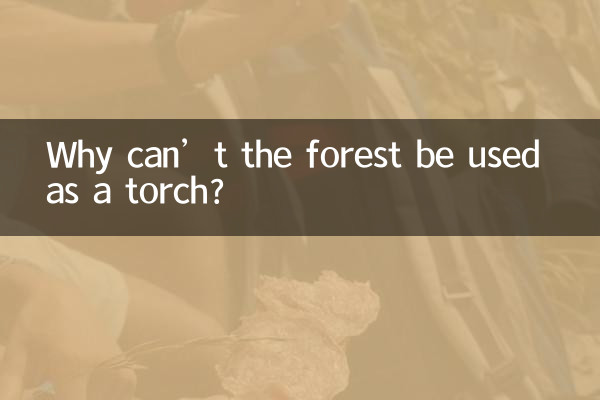Why can’t the forest be used as a torch?
In recent years, with the increase in environmental awareness, forest protection has become a hot topic around the world. However, many people may wonder: why can't the forest itself be used as a material for torches? This article will analyze this issue from the scientific, ecological and economic perspectives, and combine the hot topics of the past 10 days to reveal the complex relationship between forests and torches.
1. Scientific perspective: Burning characteristics of wood

From a scientific point of view, although wood in the forest can be burned, it has the following problems as a torch material:
| characteristic | Torch demand | Actual performance of forest wood |
|---|---|---|
| Burning time | Requires long-term stable combustion | Ordinary wood burns too quickly and needs to be replaced frequently |
| flame stability | Requires a stable, bright flame | High moisture content, unstable flame and easy smoking |
| heat output | Requires concentrated hyperthermia | Heat dispersion, low efficiency |
2. Ecological impact: unsustainability of forest resources
Hot data in the past 10 days shows that the global deforestation problem is still serious:
| area | Hot events in the past 10 days | Related data |
|---|---|---|
| amazon rainforest | Illegal logging hits new high | The average daily loss of football field area is 30 |
| Southeast Asia | Controversy over palm oil plantation expansion | Resulting in annual forest loss of 2.4 million hectares |
| congo basin | Conservation funding gap widens | Annual conservation funding gap reaches US$1 billion |
If forest wood is used to make torches, the following ecological problems will be exacerbated:
1. Biodiversity loss: Each hectare of forest contains hundreds of plant and animal species
2. Weakening of carbon sink function: Global forests absorb approximately 2.4 billion tons of carbon dioxide annually
3. Increased soil erosion: The tree canopy can reduce the direct impact of rainfall on the soil.
3. Economy and Alternatives
From an economic perspective, using forest wood for torches is inefficient:
| Material | Cost (per thousand pieces) | Burning time | Environmental protection index |
|---|---|---|---|
| pine | ¥150 | 15 minutes | Low |
| paraffin | ¥80 | 45 minutes | middle |
| LED electronics | ¥200 | 10 hours | high |
Better alternatives include:
1.Artificially planted fast-growing forest: Specially cultivated torch materials can be used in 5 years.
2.recycled materials: Compression molding using agricultural waste
3.modern lighting technology: LED and other clean energy solutions
4. Analysis of recent hotspot correlations
Combining the hot topics around the world in the past 10 days, we found:
• European energy crisis triggers re-examination of biomass energy
• UN climate report once again emphasizes the importance of forest protection
• Many countries have introduced new regulations restricting disposable wood products
These hotspots all point in the same direction: We need to use resources more intelligently, rather than simply depleting forests. The services provided by forest ecosystems (such as air purification and climate regulation) are far more valuable than being used as torch materials.
in conclusion:
Forests cannot and should not be used as torch material. From combustion efficiency, ecological protection to economic costs, there are better solutions. In the context of global climate change, protecting existing forests and developing sustainable alternatives are choices that are in the long-term interests of mankind. Next time you light a torch, consider this: Do we really need to sacrifice forests for this brief moment of light?

check the details

check the details